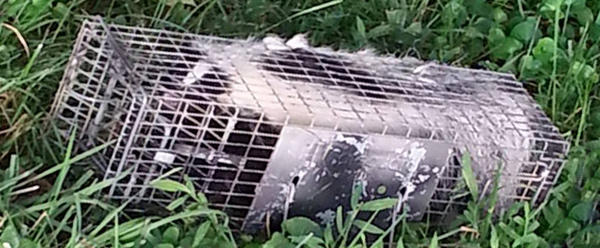- info@wildlife-removal.com
Call us for help in your town
Wildlife Removal Education
What is the best bait to trap a skunk?
Need skunk removal in your hometown? We service over 500 USA locations! Click here to hire us in your town and check prices - updated for year 2020.
Live skunk trapping is one of the most effective ways to control skunk although the challenge for most people is in not wanting to get sprayed. Read more about How to trap a skunk. Skunks are known to release an obnoxious spray when they feel threatened. It is however very possible to trap and remove a skunk without getting sprayed.

The effectiveness of your cage trap largely depends on what bait you settle for. In nature, skunks are omnivores and opportunistic feeders. Their common animal foods include worms, rodents, and even small reptiles like lizards, salamanders, frogs, snakes. They often hunt insects and insect larvae, poultry, eggs and small mammals. They are known to attack beehives to eat honeybees as their thick fur protects them from stings. As for plants, they often feed on garden vegetables and fruits, berries, grasses, and roots.
While setting a trap however, the best kind of bait that would attract your skunk would strong-smelling foods like peanut butter and fish; you can even use a combination of both. Peanut butter is particularly good because it can be smeared all over the trigger plate and there is no way even a smart skunk would eat it off without setting off the trigger that shuts the trap door.
Skunks have been ranked in the top three wildlife animals that are difficult to trapping, but using the right bait will increase your chances of success considerably. Here are a couple of baits that have been proven to work while trapping skunk:
- Canned fish (such as sardines)
- Fresh insect larvae (such as may beetles)
- Bacon
- Cat food or bread with peanut butter
- Marshmallows
It is important while positioning your bait that it is placed far inside the trap enough that the animal’s whole body would have entered the cage before the door gets shut. Otherwise, the skunk could get wounded if it gets caught by the door, or it may be able to get away.
Go back to the Skunk Removal page, or learn tips by reading How to get rid of skunks.
Trapping a skunk - Skunks that are living in your yard are probably under a building, your deck, or the patio. This critter is probably going to be easier to catch than the transient skunk that just likes your yard because of the insects in the grass. To trap a skunk, you can purchase a cage trap and set it up out in the yard. If it is baited, the skunk will usually find it. There are a few tricks that might make life easier. First, you can always hire a professional to handle a skunk issue. This eliminates your risk of being sprayed just from inexperience. Second, you can try to corral the skunk toward the trap. This method is only effective if the animal is living around the house, particularly under a deck or a building. No matter where you set your trap, and no matter what type of trap you use, you need to make sure it is on level ground. Putting out a wobbly, small trap will only encourage the skunk to stay away from the device. Skunks are not as intelligent as other nuisance animals, so as long as the trap is baited with something appealing and doesn’t move as the animal enters.


















